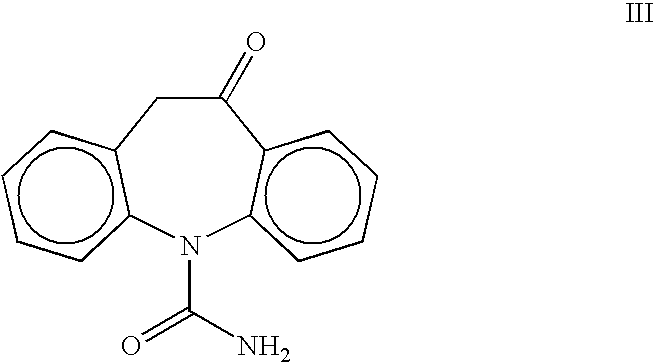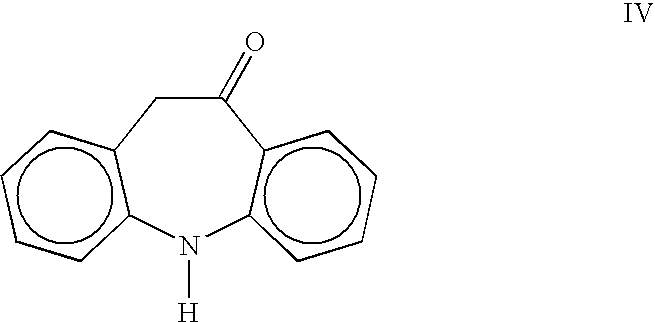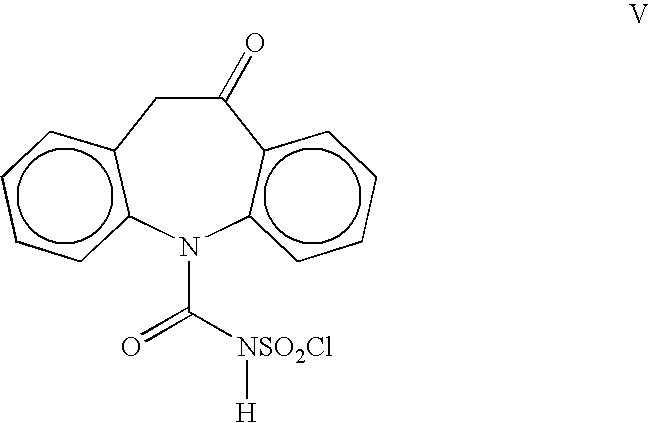Process for the preparation of oxcarbazepine and related intermediates
a technology which is applied in the field of process for the preparation of oxcarbazepine and related intermediates, and achieves the effect of facilitating the isolation of the final produ
- Summary
- Abstract
- Description
- Claims
- Application Information
AI Technical Summary
Benefits of technology
Problems solved by technology
Method used
Image
Examples
example i
Preparation of 5,11-Dihydro-10H-dibenz[b,f]azepine-10-one (Oximinostilbene) IV
[0019]A 2-L, three-necked flask equipped with a mechanical stirrer, thermometer and nitrogen inlet was charged with 10-methoxyiminostilbene I (110.0 g, 0.49 mol) and 330 mL acetone. A 10% solution of hydrochloric acid (28.6 g, 0.08 mol) was then added. The reaction mixture was stirred at ambient temperature for 1–1.5 hours until reaction completion. The product was precipitated by the addition of 660 mL of deionized water, and the resulting suspension was stirred for 3–4 hours. The suspension was filtered and washed with water. After drying, oximinostilbene (99.92 g, 97%) was obtained as a bright yellow solid having a purity of 99% by HPLC.
1H NMR (CDCl3, d): 3.80, 6.87, 7.04–7.15, 7.22–7.24, 7.32–7.37, 8.04 ppm.
example 2
Preparation of 10-Oxo-10,11-dihydro-5H-dibenz[b,f]azepin-5-carboxamide III
[0020]A 1-L, three-necked flask equipped with a thermometer, nitrogen inlet, mechanical stirrer and addition funnel, was charged with oximinostilbene IV (prepared above) followed by 400 mL dichloromethane. The suspension was cooled to 0–5° C. and a solution of chlorosulfonyl isocyanate (71.7 g, 0.50 mol) in 200 mL dichloromethane was added dropwise, maintaining the internal temperature at 0–10° C. Following the addition, the reaction mixture was maintained at 0–5° C. until reaction completion. The cold suspension was then filtered and washed giving oxcarbazepine intermediate V (163 g, 97%). The damp solid was suspended in 300 ml glacial acetic acid and cooled to 10–15° C. To the suspension was added 188 mL cold water, portionwise, maintaining the IT<20° C. The mixture was maintained at 15–25° C. for 0.5–1.0 h until reaction completion. The suspension was concentrated to 200–300 ml and 700 mL isopropanol was ad...
PUM
| Property | Measurement | Unit |
|---|---|---|
| temperature | aaaaa | aaaaa |
| temperature | aaaaa | aaaaa |
| temperature | aaaaa | aaaaa |
Abstract
Description
Claims
Application Information
 Login to View More
Login to View More - R&D
- Intellectual Property
- Life Sciences
- Materials
- Tech Scout
- Unparalleled Data Quality
- Higher Quality Content
- 60% Fewer Hallucinations
Browse by: Latest US Patents, China's latest patents, Technical Efficacy Thesaurus, Application Domain, Technology Topic, Popular Technical Reports.
© 2025 PatSnap. All rights reserved.Legal|Privacy policy|Modern Slavery Act Transparency Statement|Sitemap|About US| Contact US: help@patsnap.com



